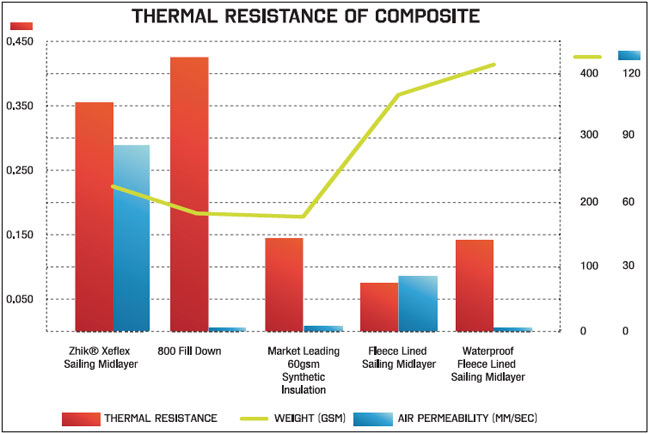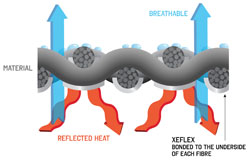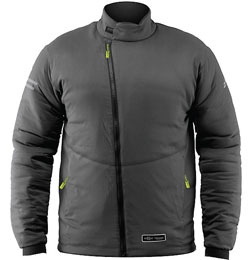

Racing hard offshore with a degree of comfort while also keeping out of the water was never an easy task
It’s not until things go badly wrong that you really get to find out what you’re made of. And in a spot it’s also when you need your clothing to work flawlessly to give you the best chance when battling adversity. Aiming to become the first female to circumnavigate Antarctica singlehanded was always going to be a mission for Lisa Blair, but then, when her mast crashed down after 71 days at sea, life suddenly became a whole lot tougher for the plucky Australian.
Blair was grabbing some sleep below decks when she heard strange noises outside as her Open 50, Climate Action Now, battled on autopilot through 40kt northwesterlies in the Indian Ocean. ‘I grabbed my lifejacket and was clipping on as I stormed towards the companionway hatch to get on deck in a real hurry. Just as I was almost there I heard the worst sound imaginable… the noise of metal screaming loudly as it rips apart.
‘It was deafening – the groaning of the mast as it toppled down, taking my chances of a world record with it. I stood there with my eyes closed as I listened, my whole body tense as my afternoon went from a pleasant sleep to survival mode.
‘When the grinding and screeching finally stopped I stood there for several more seconds in disbelief. I was only four weeks from the finish. So close. I bolted on deck in my thermals and midlayers to take a quick look…’ [See too: lisablairsailstheworld.com]
Blair’s passion for an adventurous project captured the attention of many supporters, not least innovative sailing apparel specialists Zhik, who provided her with the best kit possible for some of the toughest conditions in the world. Aside from the Australian connection, Blair also felt Zhik offered her the best garments for the job.
‘The great thing about Zhik gear is it gives you the biggest bang for buck in terms of comfort and thermal insulation, while being lightweight and low-profile – which really helps you to move around more easily on deck,’ she says.
With Blair’s 16,400-nautical mile route taking her so close to Antarctica, she was an obvious choice as an early tester of Xeflex, Zhik’s new mid-layer range that employs radiant barrier technology. Zhik R&D manager Tom Hussey explains: ‘Xeflex is a nano-thin heat metallic coating that is applied to the fabrics. It reflects radiating body heat that is not normally insulated by fibre or down insulation, reducing heat loss without adding more weight or bulk.
‘Within the Xeflex fabric the mid-layer contains a vertical lapped insulation technology. With a unique internal structure, the insulation gives a better loft, or separation, due to the vertical fibre structure being unusually resistant to compression levels.
‘Thickness has a direct influence on warmth, and when the wind blows it compresses other jacket fillings such as down and this reduces the level of warmth significantly. The vertical lapped insulation is able to maintain its thickness and warmth even when the wind is blowing hard against it. This is obviously beneficial when sailing in cold and windy conditions, which is why it was ideal for Lisa’s challenge and will also be perfect for our teams competing in the next Volvo Ocean Race.’
Since starting up about a decade ago Zhik has taken the scientific approach to all of its product R&D, working closely with the Royal Melbourne Institute of Technology (RMIT) on various collaborative projects. ‘We use RMIT because they have the best equipment and great knowledge in the garment testing space,’ says Hussey.
‘Tests on Xeflex are done via a sweating guarded hotplate. It maintains body temperature at 37°. It is then placed into a chamber to simulate different climatic conditions and we then use a standard industry test based on activity and conditions. The idea behind this process is to test the material’s thermal resistance against known benchmarks.’
Xeflex has proved to have very high levels of thermal resistance – so is good at retaining warmth. It achieves similar levels of insulation to down feathers, but for much less thickness. ‘Down and synthetic down-like jackets need to use tightly woven, high-density outer fabrics in order to prevent the feathers or fibres migrating through the fabric. But these fabrics necessarily then have low air permeability and so are not very breathable,’ explains Hussey.
‘Xeflex nano-coating means fabrics can be more “open” and breathable. We can use different insulations that do not migrate through the fabrics yet still provide very high levels of warmth. With the Xeflex mid-layer we’ve managed to match down for its thermal qualities while improving significantly on levels of breathability.’
 Above: As well as the less crushable core material in a Xeflex sailing garment the material itself features this reflective element to reduce loss of body heat
Above: As well as the less crushable core material in a Xeflex sailing garment the material itself features this reflective element to reduce loss of body heatZhik first became well known outside the Southern Hemisphere for carefully targeted (successful) development of specialised small boat clothing, working closely with some of the world’s best Olympic sailors. The company then took the same values of light weight and exceptional flexibility – two features that make sailing clothing much less tiring to wear – into their big boat garment range. This (below) is a Xeflex mid-layer, warm and breathable but again unusually thin and flexible.

While Lisa Blair’s challenge to circumnavigate Antarctica was primarily about fending off the cold of the Southern Ocean, Volvo Race sailors are required to contend with all extremes of weather, from freezing to tropical, sometimes all in the same leg. Space onboard is severely limited and the sailors are obviously restricted in terms of how much kit they bring, so the versatility of each garment is a crucial criterion for selection.
Two Volvo teams have already decided to go with Zhik as the best option for addressing the massive challenges that these mixed-gender crews will be facing. One is Dutch entry Team AkzoNobel, skippered by Volvo and America’s Cup veteran Simeon Tienpont, with a massively experienced crew that includes previous Volvo winners Brad Jackson and Stu Bannatyne from New Zealand.
The other is Dongfeng, which is back for a second assault on the race after the Chinese entry surprised a lot of people with its strong performance in the 2014-15 edition.
Frenchman Charles Caudrelier is again the skipper, along with an experienced international group as well as the core of Chinese sailors who will now be embarking on their second circumnavigation, this time with a view to winning overall.
With the advent of the one-design Volvo Ocean 65s, the margins of winning or losing a leg reduced massively compared with previous editions of the event, where the boats could finish separated by anything from a few seconds to several days.
Now in a one-design fleet the performance of the crew matters more than ever.
‘The Volvo Ocean Race is hugely demanding from a human point of view, and the welfare of my crew is paramount,’ says Caudrelier. ‘Having the right technical clothing is as race-critical as having the right food. As an elite sailing team we are always looking for the extra edge on our competitors. We share the same goal with Zhik – to optimise everything we do in every area.
‘Detail is key in this race and if we succeed in being innovative together, it could make us even more competitive on the water. Zhik can help us to perform at our peak, day and night, week after week.’
No one bears the brunt of the conditions quite like the bowman in a Volvo Ocean Race, so it makes sense that Dongfeng’s point-man Jack Bouttell has been working closely with Zhik’s designers to help them produce offshore gear that does the job that he and his fellow crewmembers need.
‘It has been a fascinating process to test new foul-weather gear and give them feedback from the front of the boat,’ says the Australian-British pro sailor. ‘We need to stay as dry as possible, and maintain ideal body temperature as much as we can. New technologies like Xeflex are really moving the game on in terms of enabling us to perform both well and also for as long as possible.’
Xeflex
Revolutionary mid-layer garments that combine Zhik’s Xeflex radiant barrier technology with compression-resistant, vertically lapped insulation to provide high levels of thermal insulation and breathability with minimal weight.
Xeflex technology reflects radiant body heat that is not normally insulated by conventional fibre or down insulations, while the vertically lapped insulation resists wind compression in all conditions.
The water-repellent composites used in Xeflex provide classleading levels of breathability, allowing the garments to be worn successfully over a very diverse range of inner layers so that the base layers through to the high performance waterproof and breathable outer shells can all function as intended.
Click here for more information on Zhik »
We invite you to read on and find out for yourself why Seahorse is the most highly-rated source in the world for anyone who is serious about their racing.
To read on simply SIGN up NOW
Take advantage of our very best subscription offer or order a single copy of this issue of Seahorse.
Online at:
www.seahorse.co.uk/shop and use the code TECH20
Or for iPad simply download the Seahorse App at the iTunes store


